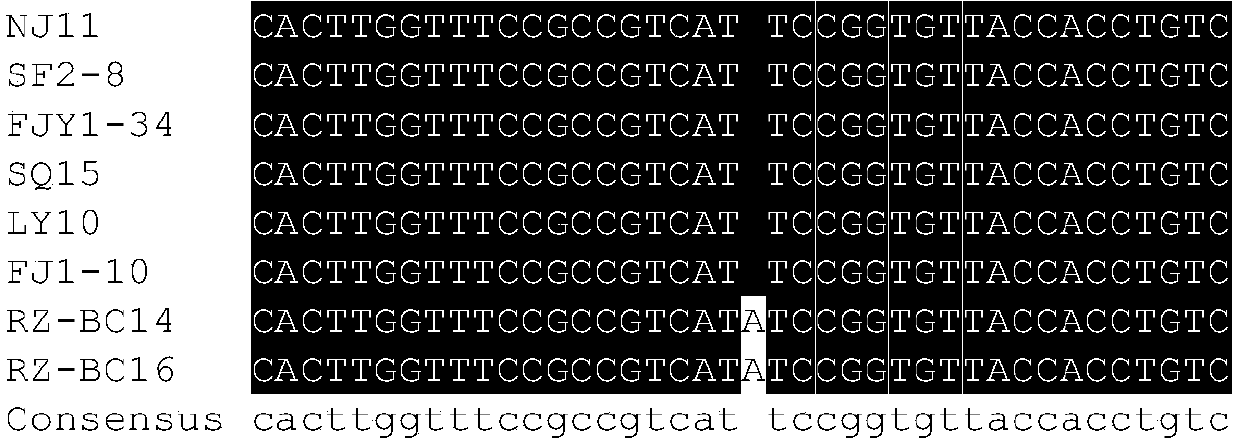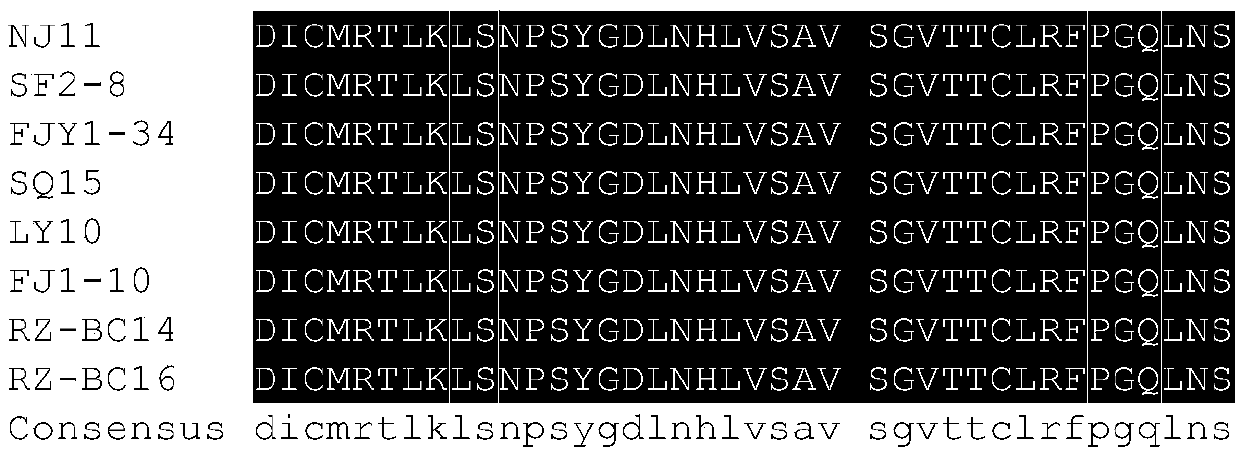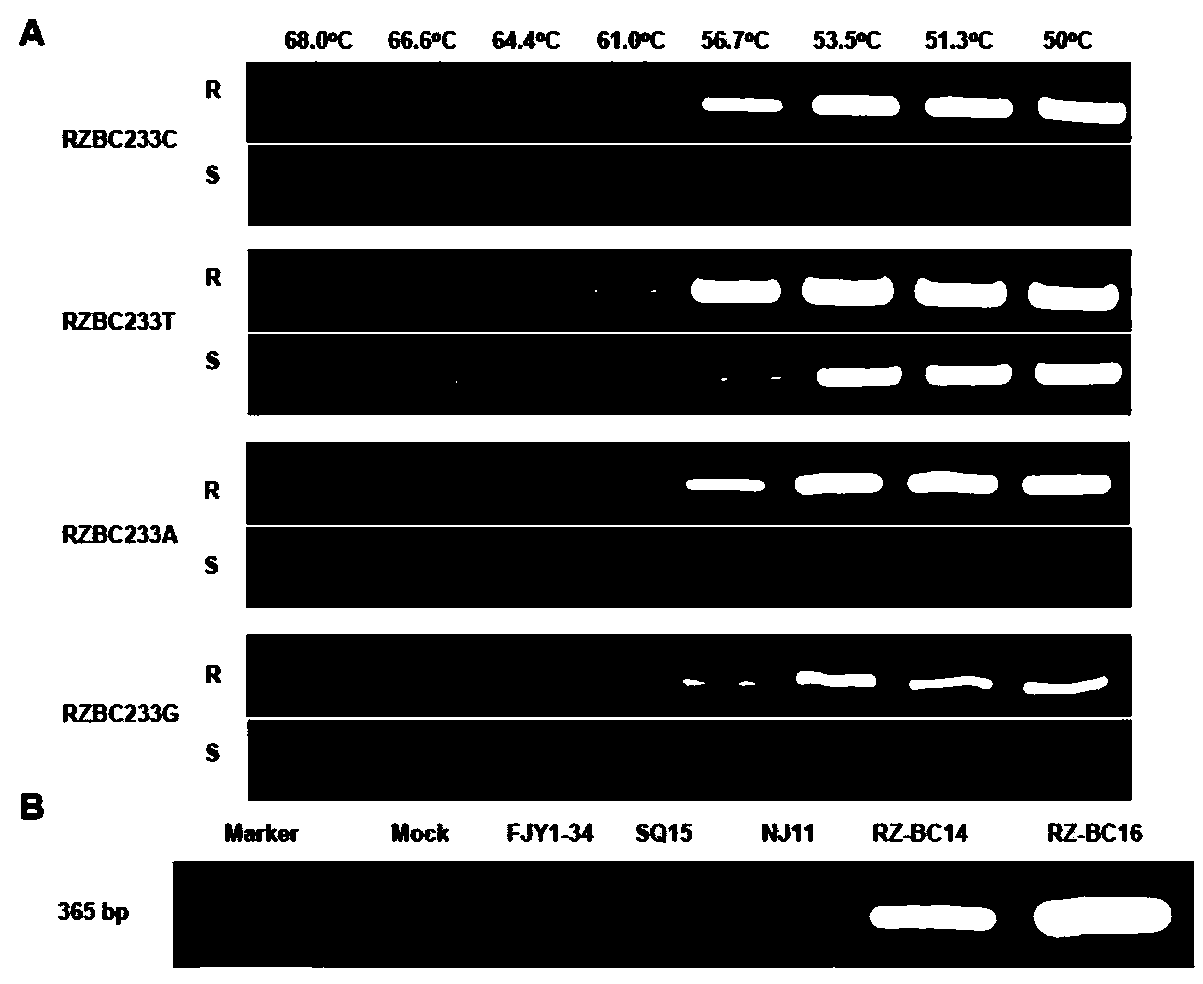Molecular detection method for identifying insecticide resistance of Botrytis cinerea on zoxamide
A technology of botrytis cinerea and drug resistance, applied in the field of molecular biology, can solve the problems of long detection cycle, heavy workload, human resources and materials, etc., and achieve the effect of delaying further development
- Summary
- Abstract
- Description
- Claims
- Application Information
AI Technical Summary
Problems solved by technology
Method used
Image
Examples
Embodiment 1
[0027] Embodiment 1, Botrytis cinerea to the sensitivity determination of benzamid
[0028] 6 sensitive strains NJ11, SF2-8, FJY1-34, SQ15, LY10 and FJ1-10; 2 resistant strains RZ-BC14 and RZ-BC16.
[0029] Potato dextrose agar medium (PDA): 200g of potatoes, 18g of glucose, 15g of agar powder, distilled water to 1L, sterilized by moist heat at 121°C for 20 minutes.
[0030] 1. The experimental steps are as follows:
[0031] 1) Mix benzamid with dimethyl sulfoxide (DMSO) to make 10 5 μg / mL stock solution. The benzamid was diluted stepwise to 4×10 2 μg / mL, 6×10 2 μg / mL, 8×10 2 μg / mL, 1×10 3 μg / mL, 2×10 3μg / mL, 4×10 3 μg / mL and 5×10 3 The concentration gradient of μg / mL, 1‰DMSO was used as blank control to determine the sensitivity of 6 Botrytis cinerea sensitive strains. For the sensitivity determination of two Botrytis cinerea resistant strains, 1‰DMSO was used as a blank control, and the concentration gradient was 3×10 3 μg / mL, 5×10 3 μg / mL, 1×10 4 μg / mL, 2.5×10 ...
Embodiment 2
[0040] Example 2, Discovery of β-tubulin gene and its corresponding protein mutation site in Botrytis cinerea
[0041] 1. Strains: resistant strains RZ-BC14 and RZ-BC16; sensitive strains NJ11, SF2-8, FJY1-34, SQ15, LY10 and FJ1-10.
[0042] 2. Method:
[0043] 1) Strain cultivation: Inoculate the pre-cultured Botrytis cinerea strains on PDA medium covered with cellophane, culture in the dark at 20°C for 3 days, collect mycelium, freeze in liquid nitrogen and store at -80°C for genomic DNA extraction.
[0044] 2) Genomic DNA of resistant strains and sensitive strains were extracted respectively.
[0045] 3) PCR amplification of the complete sequence of β-tubulin gene, the primers used are shown in Table 2.
[0046] Table 2 Primers used in the amplification of the complete sequence of the cinerea cinerea β-tubulin gene
[0047]
[0048] PCR reaction system: The PCR reaction uses the reagents of Beijing Quanshijin Biotechnology Co., Ltd., and the 50 μL reaction system incl...
Embodiment 3
[0055] Embodiment 3, the method for detecting mutation site in Botrytis cinerea
[0056] 1. Primer design
[0057] The strains are the strains NJ11, SQ15, FJY1-34, RZ-BC14 and RZ-BC16 used in Example 1.
[0058] The primers are shown in Table 3. Allele specific-PCR (AS-PCR) primers were designed according to the sequence of the mutant β-tubulin gene. The second base at the 3'-end of the forward primer RZBC233T is the mutated base. To increase the specificity of the primers, a mismatched base was introduced at the first base at the 3'-end of the forward primer (primers RZBC233A, RZBC233C and RZBC233G, the mismatched bases are underlined). The reverse primer is RZBCR.
[0059] Table 3 AS-PCR detects the primers used for Botrytis cinerea showing resistance to benzamid
[0060]
[0061] The specific reaction system is the same as in Example 2. Gradient PCR with different annealing temperatures was carried out on the primers to determine the annealing temperature with high s...
PUM
 Login to View More
Login to View More Abstract
Description
Claims
Application Information
 Login to View More
Login to View More - R&D
- Intellectual Property
- Life Sciences
- Materials
- Tech Scout
- Unparalleled Data Quality
- Higher Quality Content
- 60% Fewer Hallucinations
Browse by: Latest US Patents, China's latest patents, Technical Efficacy Thesaurus, Application Domain, Technology Topic, Popular Technical Reports.
© 2025 PatSnap. All rights reserved.Legal|Privacy policy|Modern Slavery Act Transparency Statement|Sitemap|About US| Contact US: help@patsnap.com



